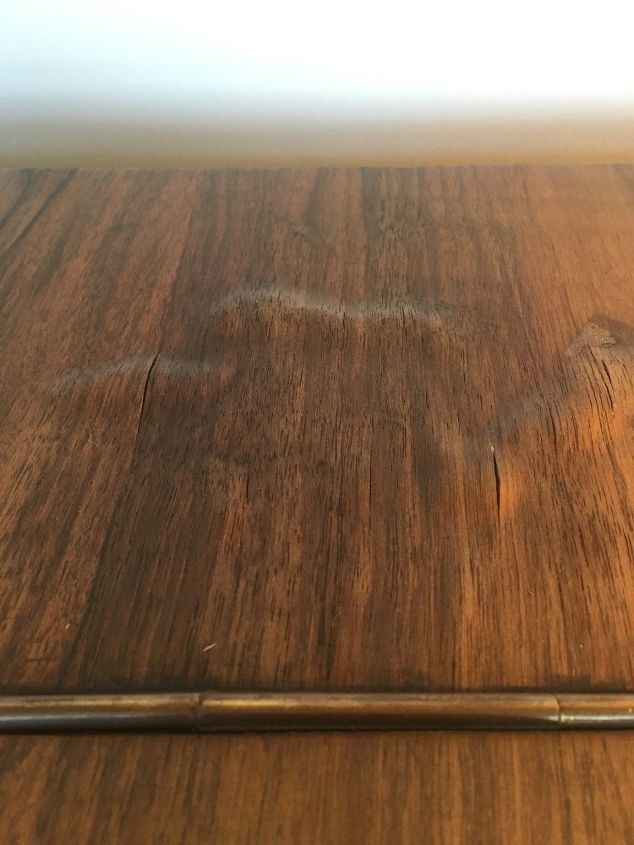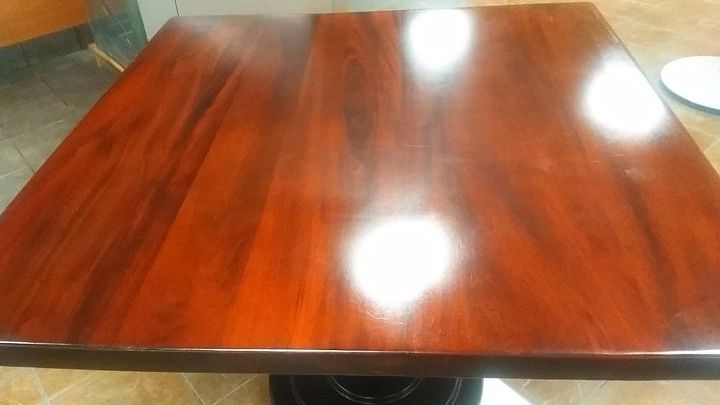Water damage to top of wooden piano

-
To aid in the water stain try rubbing coconut or olive oil with a soft cloth.
 Janet Pizaro
on May 15, 2016
Helpful Reply
Janet Pizaro
on May 15, 2016
Helpful Reply -
-
I've never seen wood bubble like that (my daughter famously spills on everything) unless its a wood veneer. To obtain a flat finish, you might have to replace the entire veneer on the top of the piano. I'd have a furniture appraiser take a look at it up close before I started just to make sure.
 Barbara
on May 15, 2016
Helpful Reply
Barbara
on May 15, 2016
Helpful Reply -
-
Coconut oil is the best for reclaiming old wood finishes and I bet it would work on this. Spread with the oil, let it sit for a while and if it softens up put a cloth with a heavy book on it for a few days.
 Gina
on May 15, 2016
Helpful Reply
Gina
on May 15, 2016
Helpful Reply -
-
It looks like it's the veneer that's bubbled, maybe apply some heat... such as with an iron over a cloth and then weight it down good with something heavy while it is still warm until it is cold and it might well stick back down.
 Eileen Proctor
on May 15, 2016
1 marked as helpful Reply
Eileen Proctor
on May 15, 2016
1 marked as helpful Reply -
-
It is veneer! The hot iron idea Eileen proposed may work. If it doesn't you may have to squeeze some glue under the veneer and use the towel and iron. If all else fails you may need to replace the veneer. You will need to peel of the veneer and sand the area smooth. There is veneer available in sheets with heat activated glue or glue a thin hardwood panel of the same type wood over the complete area and stain it as close to the finish of the piano.
 William
on May 15, 2016
1 marked as helpful Reply
William
on May 15, 2016
1 marked as helpful Reply -
-
I had a retro table top that did that. I put a good quality oil on it and covered it with a terry cloth towel. Then I got my iron out and put it on med heat and set it on the towel over the bubble to soften it up and to slowly "relax" the bubble to make it flat again. It takes patience but it was worth it. All I can see now is a small crease. Hope this helps.
 Bobbie
on May 15, 2016
Helpful Reply
Bobbie
on May 15, 2016
Helpful Reply -
-
google repair veneer. I believe it will involve some glue under the raised veneer, and some strong clamps over a board to squeeze the veneer into place. Seems like I've read about soaking it prior to the camping also, but I know I've found advice on google. I'm redoing an old sewing machine.
 Kathi Schaffeld
on May 15, 2016
1 marked as helpful Reply
Kathi Schaffeld
on May 15, 2016
1 marked as helpful Reply -
-
I refinished a piano that had been stored in a barn for years & it had a similar problem. I took a damp (not wet) towel & placed it on top. Heated the cloth with a medium heat iron until it flattened out. Then I clamped a board over the area & let it sit for a week or so. Problem solved. I was able to remove the finish & restain/seal. It's held up for over 25 years. The inside repairs were done by a professional (very expensive) but after 20 years in the barn the working parts were shot. This was a gift to my husband whose grandparents transported that piano across the US in a covered wagon in about 1902 from the east coast to N. Dakota to Oregon.
 Barbara
on May 15, 2016
1 marked as helpful Reply
Barbara
on May 15, 2016
1 marked as helpful Reply- See 1 previous
-
-
I'm working with all of your suggestions. I'll take some pictures in a few days, when the process is finished. Thank you all!
 Jackie Collins
on May 16, 2016
Helpful Reply
Jackie Collins
on May 16, 2016
Helpful Reply -
-
It probably took about 5 minutes with the iron.
 Barbara
on May 16, 2016
Helpful Reply
Barbara
on May 16, 2016
Helpful Reply -
-
Also try laying a heavy towel on it and iron it with hot iron
 Susan
on May 17, 2016
Helpful Reply
Susan
on May 17, 2016
Helpful Reply -
Related Discussions
How to get rid of mice?
We seem to have some unwelcome Mickeys and Minnies in our house. What is the best way to get rid of them?
How to remove popcorn ceiling with asbestos?
I want to remove my popcorn ceiling, but it has asbestos in it. How do I go about this safely?
How to caulk baseboard gaps?
How do I fill gaps at baseboard, should I caulk? If so, does anyone know how to caulk baseboards?
How to fix squeaky hardwood floors?
How do I fix squeaky hardwood floors?
How can I remove these water marks from wood tables?
My husband bought these tables and a few of them are in good condition while some have like water marks on them (not sure though). I would like to know what could I ... See more
Cat scratch pulls on a couch
I have an ivory, jacqaurd fabric couch. I recently rescued two young cats and one has claws. I came home one day to find she scratched the front of the arms. They had... See more







